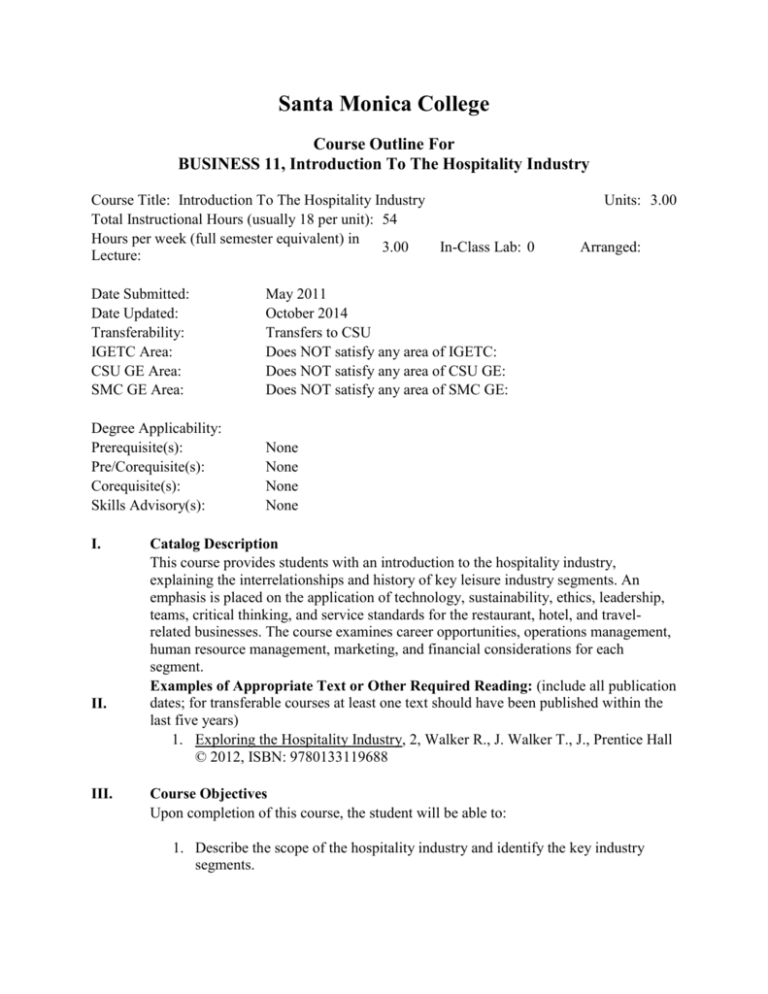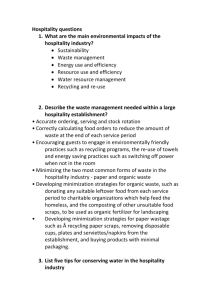Introduction To The Hospitality Industry
advertisement

Santa Monica College Course Outline For BUSINESS 11, Introduction To The Hospitality Industry Course Title: Introduction To The Hospitality Industry Total Instructional Hours (usually 18 per unit): 54 Hours per week (full semester equivalent) in 3.00 In-Class Lab: 0 Lecture: Date Submitted: Date Updated: Transferability: IGETC Area: CSU GE Area: SMC GE Area: May 2011 October 2014 Transfers to CSU Does NOT satisfy any area of IGETC: Does NOT satisfy any area of CSU GE: Does NOT satisfy any area of SMC GE: Degree Applicability: Prerequisite(s): Pre/Corequisite(s): Corequisite(s): Skills Advisory(s): None None None None I. II. III. Units: 3.00 Arranged: Catalog Description This course provides students with an introduction to the hospitality industry, explaining the interrelationships and history of key leisure industry segments. An emphasis is placed on the application of technology, sustainability, ethics, leadership, teams, critical thinking, and service standards for the restaurant, hotel, and travelrelated businesses. The course examines career opportunities, operations management, human resource management, marketing, and financial considerations for each segment. Examples of Appropriate Text or Other Required Reading: (include all publication dates; for transferable courses at least one text should have been published within the last five years) 1. Exploring the Hospitality Industry, 2, Walker R., J. Walker T., J., Prentice Hall © 2012, ISBN: 9780133119688 Course Objectives Upon completion of this course, the student will be able to: 1. Describe the scope of the hospitality industry and identify the key industry segments. 2. Identify the career opportunities within the hospitality industry and the educational and training requirements to enter and be successful in this industry. 3. Trace the origins, growth, size and scope of the hospitality industry. 4. Distinguish among the various types of operations within the hospitality industry and describe the globalization of this industry. 5. Identify the overall organizational structure and management of the lodging, food service and tourism systems within the hospitality industry. 6. Explain current trends within the industry, both domestic and foreign, and forecast several factors that are likely to affect the future of the hospitality industry. 7. Summarize the basic principles and concepts of sustainability and ?green? practices in the hospitality and tourism industries. IV. V. Methods of Presentation: Lecture and Discussion , Other (Specify) Other Methods: Lecture, discussion, guest speakers, small group work, on-line communication Course Content % of course Topic 5% Nature of the hospitality industry 5% Career opportunities 5% History of hospitality 20% Functional areas in hospitality, including management, marketing, finance, human resources, etc. 4% Crisis management, e.g. terrorism, natural disasters 5% Ethics in hospitality management 6% Sustainability and green practices in hospitality 5% Lodging 5% Cruising 5% Restaurants 5% Managed Services 5% Beverages 5% Clubs 5% Theme Parks and Attractions 5% Gaming Entertainment 5% Meetings, Conventions, and Expositions 5% Special Events 100% VI. Total Methods of Evaluation: (Actual point distribution will vary from instructor to instructor but approximate values are shown.) Percentage Evaluation Method VII. 30 % Exams/Tests 20 % Simulation 20 % Final exam 30 % Written assignments 100 % Total Sample Assignments: 1. Participate in a threaded discussion on a current issue in the hospitality industry. 2. Complete a situation analysis of a hospitality service provider. VIII. Student Learning Outcomes 1. Explore job opportunities in the hospitality industry and develop a career portfolio. 2. Identify key issues and trends, such as threats or opportunities for sustainable operations, economic conditions, etc. in a leisure industry segment. 3. Demonstrate a level of engagement in the subject matter that reveals their understanding of the value of the course content beyond the task itself, specifically as it relates to linking the relevance of course content to careers in business and accounting and their personal lives.




